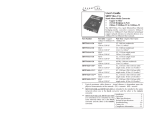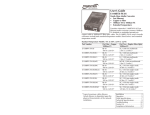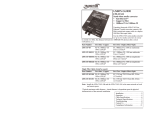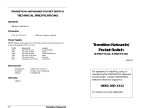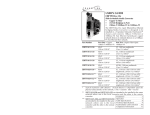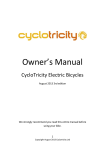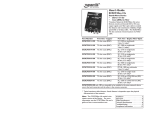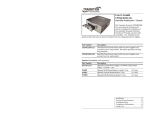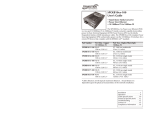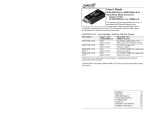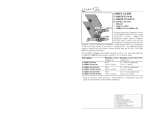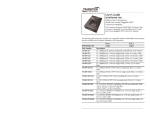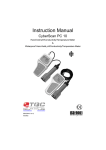Download Transition Networks SBFTF10XX-10X User's Manual
Transcript
User’s Guide SBFTF10xx-10x Stand Alone Media Converter • Copper to Fiber • 10/100 Bridging (2-Port) • 10/100Base-TX to 100Base-FX The SBFTF10xx-10x 2-port Ethernet/fast Ethernet bridging media converter connects 10Base-T Ethernet or 100Base-TX fast Ethernet twisted-pair copper network devices to network devices on a 100Base-FX fast Ethernet fiber network. Part Number Port One - Copper 10Base-T/100Base-TX Port Two - Duplex Fiber-Optic 100Base-FX SBFTF1011-100 SBFTF1015-100 (long haul) RJ-45 100 m (328 ft)* RJ-45 100 m (328 ft)* RJ-45 100 m (328 ft)* RJ-45 100 m (328 ft)* ST, 1300 nm multimode 2 km (1.2 miles)* SC, 1300 nm multimode 2 km (1.2 miles)* SC, 1310 nm single mode 20 km (12.4 miles)* SC, 1310 nm single mode 40 km (24.8 miles)* SBFTF1016-100 (extra long haul) SBFTF1017-100 (long wave length) RJ-45 100 m (328 ft)* RJ-45 100 m (328 ft)* SC, 1310 nm single mode 60 km (37.2 miles)* SC, 1550 nm single mode 80 km (49.7 miles)* SBFTF1018-100 RJ-45 100 m (328 ft)* MT-RJ, 1300 nm multimode 2 km (1.2 miles)* SBFTF1019-100 RJ-45 100 m (328 ft)* LC, 1310 nm single mode 20 km (12.4 miles* SBFTF1013-100 SBFTF1014-100 *Typical maximum cable distance. Actual distance is dependent upon the physical characteristics of the network installation. The chassis version of the media converter is CBFTF10xx-10x. For more information, see the CBFTF10xx-10x user’s guide online at: www.transition.com. Installation . . . . . . . . . . . . . . . . . .2 Operation . . . . . . . . . . . . . . . . . . .6 Half-Duplex Network . . . . . . . . . .9 Cable Specifications . . . . . . . . . .11 Technical Specifications . . . . . . .13 Troubleshooting . . . . . . . . . . . . .13 Compliance Information . . . . . . .15 Contact Us . . . . . . . . . . . . . . . . .16 SBFTF10xx-10x Part Number Port One - Copper Port Two - Simplex Fiber-Optic SBFTF1029-100 ** RJ-45 100 m (328 ft)* RJ-45 100 m (328 ft)* RJ-45 100 m (328 ft)* RJ-45 100 m (328 ft)* RJ-45* 100 m (328 ft) RJ-45* 100 m (328 ft)* SC, 1310 nm (TX)/1550 nm (RX) single mode, 20 km (12.4 miles)* SC, 1550 nm (TX)/1310 nm (RX) single mode, 20 km (12.4 miles)* SC, 1310 nm (TX)/1550 nm (RX) single mode, 40 km (24.8 miles)* SC, 1550 nm (TX)/1310 nm (RX) single mode, 40 km (24.8 miles)* SC, 1550 nm single mode, 120 km (74.6miles)* LC, 1300 nm multimode, 2 km (1.2 miles)* SBFTF1029-101 ** SBFTF1029-102 ** SBFTF1029-103 ** SBFTF1035-100 Long Wave length SBFTF1039-100 *Typical maximum cable distance. Actual distance is dependent upon the physical characteristics of the network. (TX) = transmit (RX) = receive **CBFTF1029-100/101 pair or -102/103 pair should be installed in the same network where one as local and the other is the remote converter. Installation The configuration switches are located on the side of the media converter. Use a small, flat-blade screwdriver or a similar device to set each switch. NOTE: • Switches 1, 2, 3, and 5 apply to the copper port. • Switch 4 applies to the fiber port. • Switch 6 applies to the media converter. 1. Twisted-Pair Auto-Negotiation 2. Twisted-Pair Rate DOWN - Sets the twisted-pair rate to 10Base-T. 3. Twisted-Pair Mode UP (Full-Duplex): The twisted-pair cable distances are constrained by the cable requirements (see pages 1 and 2). DOWN (Half-Duplex): At the 100Base-TX rate, the twisted-pair cable distances are constrained by the 512-Bit Rule (see page 9). 3 UP Twisted-pair Full-Duplex DOWN Twisted-pair Half-Duplex At the 10Base-T rate, the twisted-pair cable distances are constrained by the 5-Segment Rule (see page 10). 4 UP (Full-Duplex) - The fiber cable distances are UP constrained by the cable requirements (see pages 1 and 2). Fiber Full-Duplex DOWN (Half-Duplex) - The fiber cable distances are constrained by the 512-Bit Rule (see page 10). DOWN Fiber Half-Duplex 5. AutoCross 5 UP (Enable) - The media converter connects UP automatically to either straight-through or crossover AutoCross Enable twisted-pair copper cable. 1 UP Twisted-pair Auto-Negotiation ON DOWN DOWN (Disable) - Either straight-through or DOWN crossover twisted-pair copper cable must be AutoCross Disable installed, according to the site requirements. Twisted-pair Auto-Negotiation OFF DOWN (Disabled) - The bridging media converter does not “advertise” the rate and mode capabilities to the network. Switch #2 and switch #3 are then used to set the twisted-pair rate and mode. UP - Sets the twisted-pair rate to 100Base-TX. Set the Configuration Switches - Continued 4. Fiber Mode Set the Configuration Switches UP (Enabled) - The media converter “advertises” ALL rate and mode capabilities to the network: • 100Mb/s full-duplex, • 100Mb/s half-duplex, • 10Mb/s full-duplex, and • 10Mb/s half-duplex. Installation -- Continued 2 UP Twisted-pair 100Base-TX DOWN 6. Link Pass-Through 6 UP (Enable) - When Link Pass-Through is enabled, a UP fault on one side of the media converter stops the Link Pass-Through Enable signal and data transmission on the other side. DOWN (Disable) - When Link Pass-Through is DOWN disabled, a fault on one side of the media converter does not stop the signal and data transmission on Link Pass-Through Disable the other side. Twisted-pair 10Base-T 2 24-Hour Technical Support: 1-800-260-1312 -- International: 00-1-952-941-7600 [email protected] -- Click the “Transition Now” link for a live Web chat. 3 SBFTF10xx-10x Installation -- Continued Installation -- Continued Connect the Twisted-Pair Copper Cable Connect the Fiber Cable Ensure that the correct cable type is installed to support the highest speed and mode of operation to be selected. 100Base-FX / fast Ethernet collision domain Although Category 3 cable is adequate for the 10Base-T installation, Category 5 cable is strongly recommended, since Category 3 cable can not be used for 100Base-TX installation. 10Base-T / Ethernet collision domain • • If half-duplex cable is used, refer to the 5-Segment Rule (page 10) before installing the 10Base-T twisted-pair copper cable. If full-duplex cable is used, the 5-Segment Rule does not apply. The cable lengths are constrained by the cable requirements (see pages 1 and 2). 100Base-TX / fast Ethernet collision domain • If half-duplex cable is used, refer to the 512-Bit Rule (page 10) before installing the 100Base-TX twisted-pair copper cable. • If full-duplex cable is used, the 512-Bit Rule does not apply. The cable lengths are constrained by the cable requirements (see pages 1 and 2). • If half-duplex mode is used, refer to the 512-Bit Rule (page 9) before installing the 100Base-FX fiber cable. • If full-duplex mode is used, the 512-Bit Rule does not apply. The cable lengths are constrained by the cable requirements (see pages 1 and 2). Install the Fiber Cable 1. Locate or build IEEE 803.2™ compliant 100Base-FX fiber cable with male, two-stranded TX to RX connectors installed at both ends. 2. Connect the fiber cables to the SBFTF10xx-10x as described: • Connect the male TX cable connector to the female TX port. • Connect the male RX cable connector to the female RX port. 3. Connect the fiber cables to the other device (another media converter, hub, etc.) as described: • Connect the male TX cable connector to the female RX port. • Connect the male RX cable connector to the female TX port. Connect fiber cable to media converter as shown. NOTE: A fast Ethernet collision domain can have one one class I repeater or two class II repeaters. RX TX Install the Twisted-Pair Copper Cable NOTE: The AutoCross feature allows either MDI (straight-through) or MDI-X (crossover) cable connections to be configured automatically, according to the network conditions. 1. Locate or build IEEE 803.2™ compliant 10Base-T or 100Base-TX cables, with RJ-45 connectors installed at both ends. 2. Connect the RJ-45 connector at one end of the cable to the RJ-45 port on the SBFTF10xx-10x media converter. 3. Connect the RJ-45 connector at the other end of the cable to the RJ-45 port on the other device (switch, workstation, etc.). Connect fiber cable to other device (media converter, hub, etc.) as shown RX TX Power the Media Converter NOTE: The external power supply provided with this product is UL listed by the power supply’s manufacturer. AC 1. Connect the barrel connector on the power adapter to the media converter’s power port (located on the back of the media converter). 2. Connect the power adapter plug to AC power. 3. Verify that the media converter is powered by observing the illuminated LED power indicator light. DC RJ-45 port on the media converter 4 RJ-45 port on the other device (switch, work station, etc.) 24-Hour Technical Support: 1-800-260-1312 -- International: 00-1-952-941-7600 Consult the user’s guide for the Transition Networks SPS1872-xx DC external power supply for powering the media converter. [email protected] -- Click the “Transition Now” link for a live Web chat. 5 SBFTF10xx-10x Operation Operation -- Continued Using the Status LEDs Product Features Use the status LEDs to monitor the media converter and the network connections. The “FD” and “LACT” LEDs refer to the fiber port. F(ull) D(uplex) On = Full-duplex fiber connection. Off = Half-duplex fiber connection. L(ink) ACT(ivity) On = Fiber link connection. Flashing = Fiber network activity. P(o)W(e)R On = Connection to external AC or DC power. Duplex/Link Speed FD LACT PWR 100Base-FX 10/100TX The two-color LEDs refer to the twisted-pair copper port. Duplex/Link LED Amber = A link on the half-duplex twisted-pair copper link. Flashing Amber = Activity on the half-duplex copper link. Rate Conversion The media converter allows connection of 10Mb/s terminal devices on a 10Base-T legacy Ethernet copper network to 100Mb/s terminal devices on a 100Base-TX fast Ethernet copper network and/or to 100Mb/s terminal devices on a 100Base-FX fast Ethernet fiber network. Auto-Negotiation The Auto-Negotiation feature allows the SBFTF10xx-10x media converter to automatically configure itself to achieve the best possible mode of operation over a link. The media converter broadcasts its speed (10 Mb/s or 100 Mb/s) and duplex capabilities (full or half) to the other devices and negotiates the best mode of operation. Auto-Negotiation allows quick and easy installation because the optimal link is established automatically. A scenario where the media converter is linked to a non-negotiating device is a case where the user may want to disable Auto-Negotiation. In this instance, the mode of operation will drop to the least common denominator between the two devices (e.g.: 10 Mb/s, half-duplex). Disabling this feature gives the user the ability to force the connection to the desired speed and duplex mode of operation. AutoCross™ When the AutoCross feature is activated, it allows either straight-through (MDI) or crossover (MDI-X) copper cables to be used when connecting to 10Base-T or 100Base-TX devices. AutoCross determines the characteristics of the connection and automatically configures the unit to link up, regardless if the copper cable is MDI or MDI-X configuration. (Transition networks recommends leaving the device in the default “enable” mode.) Green = A link on the full-duplex twisted-pair copper link. Flashing Green = Activity on the full-duplex copper link. Speed LED Amber = 10 Mb/s operation. Green = 100 Mb/s operation. 6 24-Hour Technical Support: 1-800-260-1312 -- International: 00-1-952-941-7600 Link Pass-Through The Link Pass-Through feature allows the media converter to monitor both the fiber and copper RX (receive) ports for loss of signal. In the event of a loss of an RX signal (1), the media converter will automatically disable the TX (transmit) signal (2), thus, “passing through” the link loss (3). The far-end device is automatically notified of the link loss (4), which prevents the loss of valuable data unknowingly transmitted over an invalid link. [email protected] -- Click the “Transition Now” link for a live Web chat. 7 SBFTF10xx-10x Operation -- Continued Product Features -- Continued Distance Extension The SBFTF10xx-10x media converter segments 10Base-T copper Ethernet and/or 100Base-TX copper fast Ethernet and 100Base-FX fiber fast Ethernet collision domains. In a half-duplex Ethernet or fast Ethernet environment, the SBFTF10xx-10x media converter extends network distances by segmenting collision domains so that the 5-Segment Rule (see page 10) or the 512-Bit Rule (see pages 9 and 10) applies separately to each collision domain. In a full-duplex Ethernet or fast Ethernet environment, the SBFTF10xx-10x media converter extends network distances to the physical cable limitations imposed by the selected copper and fiber cables (see pages 1 and 2). Congestion Reduction The SBFTF10xx-10x media converter does not forward collision signals or error packets from one collision domain to another, improving baseline network performance. In addition, the media converter filters packets destined for local devices, also reducing network congestion. Half-Duplex Network 512-Bit Rule - 100Base-TX or 100Base-FX Use the 512-Bit Rule to calculate the 100Base-TX or 100Base-FX half-duplex collision domain. In a half-duplex network, the maximum cable lengths are determined by the round trip delay limitations of each fast Ethernet collision domain. (A collision domain is the longest path between any two terminal devices, e.g. a terminal, switch, or router.) The 512-Bit Rule determines the maximum length of cable permitted by calculating the round-trip delay in bit-times (BT) of a particular collision domain. If the result is less than or equal to 512 BT, the path is good. To calculate the round-trip delay for a collision domain: 1. Find the collision domain, i.e. the longest path between any two terminal devices Class I hub Class II hub (e.g., terminal, switch, and/or router). 2. Calculate the round-trip delay in bit- terminal/router 1 meter TP cable times for each length of cable. 1 meter fiber cable 4. Determine the bit-time values for each Fast Ethernet switch device (see table to the right). SBFTF10xx-10x 3. Add the bit-time values for each length of cable and the bit-times for each device. 140 BT 92 BT 50 BT 1.11 BT 1 BT 50 BT 50 BT NOTE: The 512-Bit Rule applies separately to each collision domain. Optional Accessories (sold separately) Part Number Description SPS-1872-SA Optional External Power Supply; 18-72VDC Stand-Alone Output: 12.6VDC, 1.0 A SPS-1872-PS Optional External Power Supply; 18-72VDC Piggy-back; Output: 12.6VDC, 1.0 A E-MCR-04 12-Slot Media Converter Rack (includes universal internal power supply) 17 x 15 x 5 in. (432 x 381 x 127 mm) WMBL Optional Wall Mount Brackets; Length: 4.7in. (119mm) WMBV Optional Vertical Mount Bracket; Length: 5.0 in. (127 mm) WMBD Optional DIN Rail Mount Bracket; Length: 5.0 in. (127 mm) WMBD-F Optional DIN Rail Mount Bracket (flat); Length: 3.3in. (84 mm) 100Base-TX Twisted-Pair Example In the example below, the SBFTF10xx-10x 2-Port bridging media converter acts as a switch. In this case, the collision domain bound by the media converter on one end and a terminal on the other. 100 meters TP cross-over = 111BT 10 meters TP straight-through = 11.1BT 10 meters TP cross over = 11.1BT class II hub = 92BT class II hub = 92BT terminal = 50 BT media converter = 50BT Since the total of the bit-times in this example is less than 512 (see chart below), the path is good. Sum of the bit-times for the example collision domain: Media converter = 50.0 BT 100 m TP cable (100m x 1.11 BT/m) = 111.0 BT Two Class II hubs (2 x 92) = 184.0 BT Two 10 m TP cables (2 x 10m x 1.11 BT/m) = 22.2 BT Terminal = 50.0 BT Total = 417.2 BT 8 24-Hour Technical Support: 1-800-260-1312 -- International: 00-1-952-941-7600 [email protected] -- Click the “Transition Now” link for a live Web chat. 9 SBFTF10xx-10x Half-Duplex Network -- Continued Cable Specifications 100Base-TX Fiber Example The drawing to the right illustrates a collision domain where two media converters are connected via fiber cable. The physical characteristics must meet or exceed IEEE 802.3™ specifications. Fiber Cable 400 meters fiber cable = 400BT Since the total of the bit-times in this example is less than 512 (50BT + 400BT + 50BT = media converter = 50BT 500BT) the path is good. media converter = 50BT 5-Segment Rule - 10Base-T Use the 5-Segment Rule to calculate the 10Base-T half-duplex collision domain. The 5-Segment rule states that a transmission path of a collision domain can consist of no more than 5 segments. A “collision domain” and a “segment” are defined as follows: A collision domain is the longest path in a 10Base-T network between any two terminal devices, e.g. a terminal, switch, or router. The SBFTF10xx-10x media converter is also a terminal device. A segment is a cable connection between any two network interfaces within a collision domain. media converter 1 100 meters TP cross-over 10Base-T Twisted-Pair Example The example to the right illustrates applying the 5-Segment Rule. The cable between each network device (media converter, Hub, or Terminal) is numbered as a “segment”. 100 meters TP straight-through Note that the longest transmission path (from the media converter at the top to the terminal at the bottom) is 5 segments. Therefore, the network in this example complies with the 5-Segment Rule. 100 meters TP straight-through NOTE: The 5-Segment Rule must be applied separately to each 10Base-T collision domain. 2 hub 2 100 meters TP cross-over 3 Bit Error Rate: single mode fiber (recommended): Multimode fiber (recommended): Multimode fiber (optional): <10-9 9 µm 62.5/125 µm 100/140, 85/140, 50/125 µm SBFTF1011-100 SBFTF1013-100 Fiber Optic Transmitter Power: Fiber Optic Receiver Sensitivity: Link Budget: 1300 nm multimode 1300 nm multimode min: -19.0 dBm max: -14.0 dBm min: -30.0 dBm max: -14.0 dBm 11.0 dB SBFTF1014-100 Fiber-optic Transmitter Power: Fiber-optic Receiver Sensitivity: Link Budget: 1310 nm single mode min: -15.0 dBm max: -8.0 dBm min: -31.0 dBm max: -8.0 dBm 16.0 dB SBFTF1015-100 (long haul) Fiber-optic Transmitter Power: Fiber-optic Receiver Sensitivity: Link Budget: 1310 nm single mode min: -8.0 dBm max: -2.0 dBm min: -34.0 dBm max: -7.0 dBm 26.0 dB SBFTF1016-100 (extra long haul) Fiber-optic Transmitter Power: Fiber-optic Receiver Sensitivity: Link Budget: 1310 nm single mode min: -5.0 dBm max: 0.0 dBm min: -34.0 dBm max: -7.0 dBm 29.0 dB SBFTF1017-100 (long wave length) Fiber-optic Transmitter Power: Fiber-optic Receiver Sensitivity: Link Budget: 1550 nm single mode min: -5.0 dBm max: 0.0 dBm min: -34.0 dBm max: -7.0 dBm 29.0 dB SBFTF1018-100 Fiber-optic Transmitter Power: Fiber-optic Receiver Sensitivity: Link Budget: 1300 nm multimode min: -19.0 dBm max: -14.0 dBm min: -33.5 dBm max: -14.0 dBm SBFTF1019-100 Fiber-optic Transmitter Power: Fiber-optic Receiver Sensitivity: Link Budget: 1310 nm single mode min: -15.2 dBm max: -8.0 dBm min: -32.5 dBm max: -3.0 dBm 17.3 dB hub 3 100 meters TP cross-over hub 100 meters TP straight-through 4 4 100 meters TP cross-over 100 meters TP straight-through hub 5 10 24-Hour Technical Support: 1-800-260-1312 -- International: 00-1-952-941-7600 [email protected] -- Click the “Transition Now” link for a live Web chat. 11 SBFTF10xx-10x Cable Specifications -- Continued Technical Specifications For use with Transition Networks Model SBFTF10xx-10x or equivalent. SBFTF1029-100 SBFTF1029-101 Fiber-optic Transmitter Power: Fiber-optic Receiver Sensitivity: Link Budget: 1310 nm (TX) / 1550 nm (RX) simplex 1550 nm (TX) / 1310 nm (RX) simplex min: -13.0 dBm max: -6.0 dBm min: -32.0 dBm max: -3.0 dBm 19.0 dB Standards IEEE 802.3™ Data Rate 10 Mb/s, 100 Mb/s Dimensions 3.25" x 1.0" x 4.7" (83 x 25 x 119 mm) Weight 10 oz. (283 g) (approximate) SBFTF1029-102 SBFTF1029-103 Fiber-optic Transmitter Power: Fiber-optic Receiver Sensitivity: Link Budget: 1310 nm (TX) / 1550 nm (RX) simplex 1550 nm (TX) / 1310 nm (RX) simplex min: -8.0 dBm max: -3.0 dBm min: -33.0 dBm max: -3.0 dBm 25.0 dB Power Consumption 4.95 watts Power Supply SBFTF1035-100 (long wave) Fiber Optic Transmitter Power: Fiber Optic Receiver Sensitivity: Link Budget: 1550 nm multimode min: 0.0 dBm max: +5.0 dBm min: -36.0 dBm max: -3.0 dBm 36 dB 12 VDC, 0.8 Amp (N. America, Europe, Japan, UK) 12 VDC, 1.25 Amp (Latin Am., Australia, N.Z., S. Africa) (The external power supply provided with this product is UL listed by the power supply’s manufacturer.) MTBF 426,000 hours (MIL217F2 V5.0) (MIL-HDBD-217F) 1,326,000 hours (Bellcore7 V5.0) SBFTF1039-100 Fiber Optic Transmitter Power: Fiber Optic Receiver Sensitivity: Link Budget: 1300 nm multimode min: -19.0 dBm max: -14.0 dBm min: -30.0 dBm max: -14.0 dBm 11dB Packet Size: Memory: 256K bytes (2 Mbit) Unicast MAC addresses: 4K Maximum packet size: 1536 bytes Environment Tmra*: Storage Temp: Humidity: Altitude: Warranty Lifetime The fiber optic transmitters on this device meet Class I Laser safety requirements per IEC-825/CDRH standards and comply with 21 CFR1040.10 and 21CFR1040.11. Copper Cable Category 3: (Minimum requirement for 10 Mb/s operation) Gauge 24 to 22 AWG Attenuation 11.5 dB/100m @ 5-10 MHz Maximum Cable Distance 100 meters Category 5: (Minimum requirement for 100 Mb/s operation) Gauge 24 to 22 AWG Attenuation 22.0 dB /100m @ 100 MHz Maximum Cable Distance 100 meters • Straight-through or crossover twisted-pair cable may be used. • Shielded (STP) or unshielded (UTP) twisted-pair cable may be used. • Pins 1&2 and 3&6 are the two active pairs in an Ethernet network . • Use only dedicated wire pairs for the active pins: (e.g., blue/white & white/blue, orange/white & white/orange, etc.) • Do not use flat or silver satin wire. Straight-Through Cable Twisted Pair #1 1 2 1 2 Twisted Pair #2 3 6 3 6 *Manufacturer’s rated ambient temperature. The information in this user’s guide is subject to change. For the most up-to-date information, view the user’s guide on-line at: www.transition.com. Product is certified by the manufacturer to comply with DHHS Rule 21/CFR, Subchapter J applicable at the date of manufacture. CAUTION: Visible and invisible laser radiation when open. Do not stare into the beam or view directly with optical instruments. CAUTION: Use of controls, adjustments or the performance of procedures other than those specified herein may result in hazardous radiation exposure. Troubleshooting 1. Is the power LED illuminated? NO • Crossover Cable Twisted Pair #1 1 2 1 2 Twisted Pair #2 3 6 3 6 0 to 50°C (32 to 122°F ) -20 to 85°C (-4 to 185°F) 5 to 95%, non condensing 0 to 10,000 feet • • Is the power cord properly installed in the media converter and at the external power source? Does the external power source provide power? Contact Technical Support: US/Canada: 1-800-260-1312, International: 00-1-952-941-7600. YES • 12 24-Hour Technical Support: 1-800-260-1312 -- International: 00-1-952-941-7600 Proceed to step 2. [email protected] -- Click the “Transition Now” link for a live Web chat. 13 SBFTF10xx-10x Troubleshooting -- Continued 2. Is the “Duplex/Link” LED illuminated on the twisted-pair copper port? NO • • Check the copper cables for proper connection. Contact Tech Support: 1-800-260-1312, Int’l: 00-1-952-941-7600. YES • • • • 3. Amber = The media converter has selected half-duplex mode. Green = The media converter has selected full-duplex mode. If the mode is not correct, disconnect and reconnect the twisted pair cable to restart the initialization process. Proceed to step 3. Is the “LACT” LED illuminated on the fiber port? NO • • Check the fiber cables for proper connection. Verify that the TX and RX cables are connected to the RX and TX ports, respectively, on the 100Base-FX device. Contact Tech Support: 1-800-260-1312, Int’l: 00-1-952-941-7600. This equipment has been tested and found to comply with the limits for a Class A digital device, pursuant to part 15 of the FCC rules. These limits are designed to provide reasonable protection against harmful interference when the equipment is operated in a commercial environment. This equipment generates, uses, and can radiate radio frequency energy and, if not installed and used in accordance with the instruction manual, may cause harmful interference to radio communications. Operation of this equipment in a residential area is likely to cause harmful interference, in which case the user will be required to correct the interference at the user's own expense. Canadian Regulations This digital apparatus does not exceed the Class A limits for radio noise for digital apparatus set out on the radio interference regulations of the Canadian Department of Communications. Le présent appareil numérique n'émet pas de bruits radioélectriques dépassant les limites applicables aux appareils numériques de la Class A prescrites dans le Règlement sur le brouillage radioélectrique édicté par le ministère des Communications du Canada. European Regulations • • VCCI Class 1 Compliance • • • • Check the copper cables for proper connection. Contact Tech Support: 1-800-260-1312, Int’l: 00-1-952-941-7600. Amber = The media converter has selected 10Mb/s operation. Green = The media converter has selected 100Mb/s operation. If the speed is not correct, disconnect and reconnect the twisted pair cable to restart the initialization process. Proceed to step 5. Is the Link in the proper position? NO • • The link may “flap” (go from “link up” to “link down”) when the link is lost (if the media converter has the Link Pass-Through function enabled and is in forced 10/100 Mb mode). Contact Tech Support: 1-800-260-1312, Int’l: 00-1-952-941-7600. YES • 14 FCC Regulations Is the “Speed” LED illuminated on the twisted-pair cable port? NO YES 5. CISPR22/EN55022 Class A + EN55024 CE Mark Warning This is a Class A product. In a domestic environment this product may cause radio interference in which case the user may be required to take adequate measures. Achtung! Dieses ist ein Gerät der Funkstörgrenzwertklasse A. In Wohnbereichen können bei Betrieb dieses Gerätes Rundfunkstörungen auftreten, in diesem Fäll ist der Benutzer für Gegenmaßnahmen verantwortlich. Attention! Ceci est un produit de Classe A. Dans un environment domestique, ce produit risque de créer des interférences radioélectriques, il appartiendra alors à l'utilsateur de prende les measures spécifiques appropriées. • YES • Proceed to step 4. 4. Compliance Information Contact Tech Support: 1-800-260-1312, Int’l: 00-1-952-941-7600. 24-Hour Technical Support: 1-800-260-1312 -- International: 00-1-952-941-7600 This equipment is in the 1st Class category (information equipment to be used in commercial and/or industrial areas) and conforms to the standards set by the Voluntary Control Council For Interference by Data Processing Equipment and Electronic Office Machines aimed at preventing radio interference in commercial and/or industrial areas. When used in a residential area or in an adjacent area thereto, interference may be caused to radio and TV receivers, etc. Read the instructions for correct handling. CAUTION: RJ connectors are NOT INTENDED FOR CONNECTION TO THE PUBLIC TELEPHONE NETWORK. Failure to observe this caution could result in damage to the public telephone network. Der Anschluss dieses Gerätes an ein öffentlickes Telekommunikationsnetz in den EGMitgliedstaaten verstösst gegen die jeweligen einzelstaatlichen Gesetze zur Anwendung der Richtlinie 91/263/EWG zur Angleichung der Rechtsvorschriften der Mitgliedstaaten über Telekommunikationsendeinrichtungen einschliesslich der gegenseitigen Anerkennung ihrer Konformität. [email protected] -- Click the “Transition Now” link for a live Web chat. 15 Contact Us Technical Support Technical support is available 24 hours a day. US and Canada: 1-800-260-1312 International: 00-1-952-941-7600 Transition Now Chat live via the Web with Transition Networks Technical Support. Log onto www.transition.com and click the Transition Now link. Web-Based Seminars Transition Networks provides seminars via live web-based training. Log onto www.transition.com and click the Learning Center link. E-Mail Ask a question anytime by sending an e-mail to our technical support staff. [email protected] Address Transition Networks 10900 Red Circle Drive, Minnetonka, MN 55343, U.S.A. telephone: 952-941-7600, toll free: 800-526-9267, fax: 952-941-2322 Declaration of Conformity Name of Mfg: Transition Networks 10900 Red Circle Dirve, Minnetonka, MN 55343 U.S.A. Model: SBFTF10xx-10x Series Media Converters Part Number(s): SBFTF1011-100, SBFTF1013-100, SBFTF1014-100, SBFTF1015-100, SBFTF1016-100, SBFTF1017-100, SBFTF1018-100, SBFTF1019-100, SBFTF1029-100, SBFTF1029-101, SBFTF1029-102, SBFTF1029-103 , SBFTF1035-100,SBFTF1039-100 Regulation: EMC Directive 89/336/EEC Purpose: To declare that the SBFTF10xx-10x to which this declaration refers is in conformity with the following standards. CISPR 22:1993; EN 55022:1998 Class A; EN 55024:1998; FCC Part 15 Subpart B; CFR 21 subpart J; EN 61000-3-2:1995 + A14:2000; EN61000-3-3:1995 I, the undersigned, hereby declare that the equipment specified above conforms to the above Directive(s) and Standard(s). January, 2008_____ Stephen Anderson, Vice-President of Engineering Date Trademark Notice All trademarks and registered trademarks are the property of their respective owners. Copyright Restrictions © 2001-2005 Transition Networks. All rights reserved. No part of this work may be reproduced or used in any form or by any means - graphic, electronic, or mechanical - without written permission from Transition Networks. Printed in the U.S.A. 33221.H












